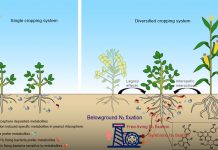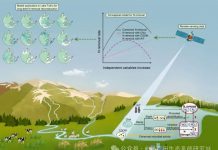Jia Deng Zaixing Zhou Xunhua Zheng Chunyan Liu Zhisheng Yao Baohua Xie Feng Cui Shenghui Han Jianguo Zhu. Annual emissions of nitrous oxide and nitric oxide from rice-wheat rotation and vegetable fields: a case study in the Tai-Lake region China. Plant Soil 2012 DOI 10.1007-s11104-012-1223-6.
Abstract
Background and aims Knowledge on nitrous oxide (N2O) and nitric oxide (NO) emissions from typical cropping systems in the Tai-Lake region is important for estimating regional inventory and proposing effective N2O and NO mitigation options. This study aimed at a) characterizing the seasonal and annual emissions of both gases from the major cropping systems and b) determining their direct emission factors (EFds) as the key parameters for inventory compilation.
Methods Measurements of N2O and NO emissions were conducted year-round in the Tai-Lake region using a static opaque chamber method. The measurements involved a typical rice-wheat rotation ecosystem and a vegetable field. The two types of croplands were subjected to both a fertilized treatment and a control treatment without nitrogen addition. In the rice-wheat ecosystem N2O emissions were measured throughout an entire year-round rotation spanning from June 2003 to June 2004 whereas NO emissions were measured only during the non-rice period. In the vegetable field both N2O and NO emissions were measured from November 2003 to November 2004.
Results During the investigation period the average cumulative N2O and NO emissions under the fertilized conditions amounted to 3.80 and 0.80 (during the nonrice period for NO) kg Nha−1 respectively in the ricewheat field and 20.81 and 47.13 kg N ha−1 respectively in the vegetable field. The average total N2O and NO emissions under the control conditions were 1.39 and 0.29 (during the non-rice period for NO) kg Nha−1 respectively in the rice−wheat rotation and 2.98 and 0.80 kg N ha−1 respectively in the vegetable field. The direct emission factor (EFd which is defined as the loss rate of applied nitrogen via N2O or NO emissions in the current season or year) of N2O was annually determined to be 0.56 % in the ricewheat field while the seasonal EFd of NO was
0.34 % during the non-rice period of the rotation cycle. In the vegetable field the seasonal EFds of N2O and NO varied from 0.15 % to 14.50 % and 0.80 % to 28.21 % respectively among different crop seasons; and the annual EFds were 1.38 % and 3.59 % respectively.
Conclusions This study suggests that conventional vegetable fields associated with intensive synthetic nitrogen application as well as addition of manure slurry may substantially contribute to the regional N2O and NO emissions though they account for a relatively small portion of the farmlands in the Tai-Lake region. However further studies to be conducted at multiple field sites with conventional vegetable and rice-based fields are needed to test this conclusion.







